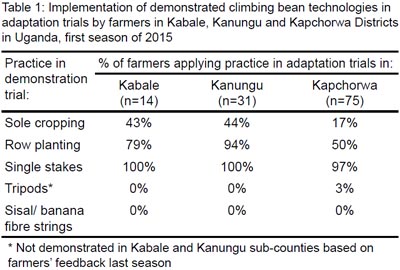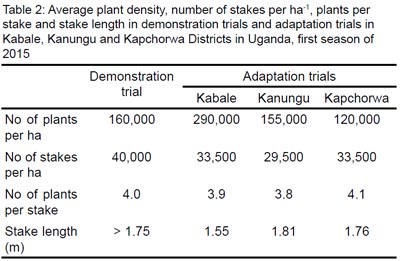Esther Ronner is research assistant employed by N2Africa at Wageningen University and is conducting her PhD studies within the project.
In June, two students from Makerere University (Florence Ajio and Ezakiel Muranda) started the collection of data among farmers with climbing bean adaptation trials in eastern Uganda (Kapchorwa District) and southwestern Uganda (Kabale and Kanungu Districts). The two students are doing an internship in the context of my PhD research on the adoption and adaptation of improved climbing bean technologies in Uganda. The students use the ‘field book for adaptation trials’, but work with additional questions on the cultivation of climbing beans including staking methods, materials, densities, length, etc. We aim to get insight in the way that different types of farmers cultivate climbing beans, and to what extent farmers apply the management practices that are shown in the demonstration trials on their own field.
| Some first findings from this season are that 124 out of the 148 farmers that were interviewed (84%) planted the adaptation trial package. A comparison between management practices applied in the demonstrations and on the adaptation trial plots showed that less than half of the farmers in Kabale and Kanungu Districts grew their beans as sole crops (Table 1), while all demonstrations were planted as sole crops. In Kapchorwa District this was even less than 20%. Most farmers intercropped their beans with banana, coffee or maize. Row planting was a common practice in Kanungu, but only applied by half of the farmers in Kapchorwa. |  |
Staking is often mentioned as major constraint for the cultivation of climbing beans. Therefore, we introduced alternative staking material of sisal string and banana fibre ropes. None of the farmers used these materials on their own field, however, despite the fact that more than half of the farmers had seen sisal strings in a demonstration, and despite positive comments by half of the farmers who had seen the method. Farmers mostly mentioned that sisal was more costly and more labour intensive than single stakes. Two farmers mentioned they had seen the strings after they had staked their own field. Another method demonstrated were tripods (three stakes tied together on top), which were used by only two farmers in Kapchorwa. These farmers mentioned that tripods gave more support to the beans than single stakes.
| The average plant density in the demonstration trials was much less than in adaptation trials in Kabale, but comparable to or higher than in trials in Kanungu and Kapchorwa (Table 2). The high densities in Kabale were mainly caused by sowing a relatively large number of seeds per hole at comparable row and plant spacing as in the demonstrations. Farmers often use high densities to compensate for poor seed quality or risk of failure through pests. |  |
The fact that staking is still often considered as a constraint is shown by the lower number of stakes per ha in the adaptation trials than in the demonstrations and points to the need to improve the availability of stakes. The number of plants per stake was however comparable to what was shown in the demonstrations. Stakes in Kanungu and Kapchorwa were of considerable length, but smaller than recommended in Kabale.
What can we, as researchers, dissemination partners, extension officers, etc. learn from these ‘adapations’ from the demonstrated practices? First, most of the farmers grow beans in intercropping, largely due to land constraints. This implies that even though farmers may be aware of advantages of sole cropping, they often do not have enough land. We should therefore diversify our research to also explore the technologies that are most suitable for intercropping (varieties, spacing of beans and intercrops, nutrient requirements, etc.). Second, although staking is still a constraint, farmers feel most comfortable with single, wooden stakes and often consider this to be the most cost and labour efficient technology after all. Strings are often demonstrated as a good alternative to wooden stakes by other projects or in other countries, but their popularity in Uganda remains to be seen. Increasing the availability of stakes through planting of multi-purpose (legume) trees around field borders may therefore be a better solution. We should therefore carefully consider how the technologies demonstrated by N2Africa ‘fit’ within current farming systems, how we could improve their fit, and how we could consider a range of technologies for farmers to pick their most preferred option from.
The two students are now back in the field to measure the harvest of the adaptation trial packages that farmers planted, and of the farmers’ own climbing beans which were planted next to the N2Africa plot for comparison. This will also give us an impression of the performance of the different packages on farmers’ fields, under different management practices. A third student (Collins Bugingo) visited farmers who participated in N2Africa in previous seasons, to look at their independent use of the improved climbing bean technologies offered by N2Africa.
I would like to take the opportunity here to thank Florence, Ezakiel and Collins for the interesting results that their work has yielded already!
Esther Ronner, Wageningen University, The Netherlands
